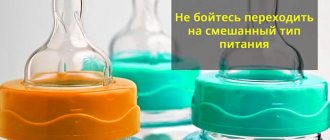For many parents, breastfeeding is a difficult but happy period. However, babies grow up and the time comes when you need to start weaning your baby from the breast. How to do everything correctly? How do experts recommend weaning? How to carry out the process painlessly and easily for mother and baby. Read the article and find out the answers to your questions.
Now let's look at this in more detail.
When and how to start weaning a child from breastfeeding?
In this matter, we often listen to our elders, who have always believed in superstitions. Here are some of them:
- after a year, milk becomes less healthy;
- after 12 months it does not satiate the child as before;
- after a year the milk becomes harmful.
You shouldn't believe this. Milk production is influenced by a special hormone (prolactin). Over time, its quantity does not decrease, but remains as in the first months of feeding. Therefore, breast milk is always beneficial. If the mother eats properly, milk will not cause harm.
Experts recommend breastfeeding a child for at least 6 months and no more than 2 years. It is better to wean your baby off breast milk at 1.5-2 years. This is the period the WHO considers optimal. At this age, the baby and mother are psychologically ready “for separation.” The baby already receives a fairly varied diet and can safely refuse breast milk.
If the mother eats properly, milk will not cause harm.
It is better to wean the baby from the mother's breast in early spring and late autumn. It is not recommended to do this in summer and winter.
- In summer , due to persistent hot weather, harmful microorganisms multiply quickly. The child may get an intestinal infection.
- And in winter, children often get the flu. Therefore, during this period, a small child needs mother’s milk as a powerful immune agent.
Optimal time
Some breastfeeding women try to wait until two years, when the baby is older and stronger, and his digestive system is ready to switch to cereals and vegetable purees. Other mothers begin weaning their baby at one to one and a half years old. From about 8–9 months, complementary foods begin to be introduced, so milk becomes a useful, but not necessary addition.
Experts sitting at the WHO advise switching to an adult menu no earlier than 1.6 or 2 years. Experienced mothers and doctors who are concerned about a woman’s physical and emotional health recommend not to force yourself if breastfeeding exhausts all your strength and does not bring pleasure. It is healthier for the child to eat formula and vegetables and see the parent happy. Love and a healthy atmosphere in the family protect against diseases no worse than breast milk and vitamin supplements.
Weaning sequence
Stopping breastfeeding is a process in which the child and mother are equally involved. They must be physically and psychologically prepared for separation.
Mom's readiness can be determined in the following way. The estimated period is 12 hours. During this time, the woman's breasts should not become full. How can you find out?
- First way . You can feed your baby with only one breast during the day. The second one should not be filled during this time.
- Second way . Leave the baby for the day with grandma or a nanny and monitor the filling of the breast.
- Third way . Watch your breasts when your child is not at home, but in kindergarten. A whole day without it, you shouldn't feel any pain or tightness.
When you see that you are ready to stop lactation, then after 8-12 weeks you will be able to finally wean your baby off the breast.
The baby's readiness is determined as follows:
- the child asks for the breast 1-3 times a day;
- such application lasts a long time from 1 to 2 months;
- The baby easily refuses bottles and pacifiers.
When the mother and child are ready for weaning, it is time to move on to its completion. There are two approaches here:
- Gradual weaning;
- Quick weaning.
Quick weaning comes down to taking medications, for example, tablets to stop lactation Agalates and stopping feeding altogether. This is stress for the baby and emotional shock for the mother. But with its help you can wean your child off the breast once and for all.
Doctors oppose rapid weaning, explaining this as a risk of loss of health for the mother and child. The baby may change greatly in behavior. He may be aggressive, refuse to eat, and have trouble sleeping. Mother's attention will help alleviate emotional stress. She should, as before, communicate with him, smile and play.
Of course, the first option is preferable. The child has experienced a close connection with his mother for a long time, so giving up her breast is very stressful for him.
How to wean gradually?
Gradual weaning comes down to a few steps:
- Reduce the number of feedings . At this step, the mother’s actions should be confident. She should not give in to the baby's demands. It is not recommended to wear things that greatly expose your chest. The child, even if he is not hungry, will definitely ask you for it. Try to distract him, turn his attention to something else.
- Teach your baby to fall asleep without breastfeeding . During the day, before going to bed, do not give him breastfeeding. Simply put your baby in bed and leave the room for a minute, explaining to your baby that he needs to sleep and you need to leave. On the first day, go back and give the baby the breast. Then the time of your absence should be increased. If you show a lot of patience, then after a few days the baby will be able to fall asleep on his own, without your breast.
- Teach your baby to fall asleep without breastfeeding at night . This step is identical to the second.
Gradual weaning does not take long because it works on the principle of one step forward, two steps back.
If a child strongly demands the breast, tries to persistently suck a pacifier, finger, or lip, do not injure him. Set aside the process for a short time. The baby is just not ready yet. But don’t give up trying, repeat the weaning after a while.
There are several recommendations for stopping breastfeeding. All of them are aimed at reducing milk production. So:
- Drink less . The liquid increases lactation, the baby easily sucks out milk. If you drink less, the sucking process will be difficult for the child. And he will gradually give up the breast.
- Reduce feeding time or skip it completely . It would be nice to distract the baby with a new and interesting activity.
- Don't express milk.
- Remove fluid through exercise.
- Do not eat foods that stimulate lactation.
When following the recommendations, follow the tips below:
- Make sure that your baby receives all the nutrients during the weaning process;
- the child should not experience hunger;
- if the baby strongly requires milk from the breast, give him a cup with this product;
- during the weaning process, caress, kiss and hug your child more;
- change where you eat. If you previously fed your baby in the living room or bedroom, move to the kitchen.
So, the mother gradually reduces the number of breastfeedings, replacing them with other nutritious foods.
How to wean your baby off breastfeeding after one year

The time comes when the mother decides that it is time to end lactation. It is necessary to find out in advance how to wean a child from breastfeeding one year and after. Then this process will be painless for both parties. The main questions: how to understand that the time has come, what to replace milk with, what to feed the child at night, what mistakes to watch out for.
- When to stop
- How to do it
- When not to wean
- How to stop milk production
- What not to do
- How to replace breast milk
- What to feed your baby at night
When to stop
Pediatrician Komarovsky believes that breastfeeding a child for up to a year is quite enough. After 12 months, the baby no longer needs breast milk as much.
If he has his first teeth, he eats fairly thick food, enjoys using different types of complementary foods, it’s time to stop lactation.
In addition, it is time for the mother to return to her social functions: calmly go about her business away from home, devote time to study, work, and communication.
By stopping breastfeeding, a woman can safely be treated with the necessary medications if she becomes ill.
The doctor notes that mother’s milk will not become harmful even after a year or after three, but there will be practically no benefit from it.
How to do it
It is best to reduce the number of breastfeedings gradually. It’s good if by the age of one year the child drinks mother’s milk only before bedtime and early in the morning.
Then it will be easier for him psychologically to wean himself off his mother’s breast. It may not replace dietary changes at all. And the mother will not have problems with excess milk.
When the number of milk feedings is greater and weaning is more abrupt, you will have to be patient.
If a child is accustomed to regular attachments, he will fight to the last. Screams, hysterics, tears... You have to go through it.
Once you start the process, you cannot show weakness. Otherwise, it may drag on for months and years.
And milk production will not stop if the baby suckles from time to time.
The mother can reassure herself that the baby does not need the breast for food. He has a psychological addiction that needs to be dealt with quickly.
At the same time, pediatricians do not consider weaning to be a great stress and lifelong trauma for the baby. If you act clearly and decisively, he will quickly forget about his worries.
An effective way is separation from the mother. 5-7 days are enough for the baby to no longer need his mother’s breast.
If, after seeing his mother, he again tries to beg for breast milk, under no circumstances should he be led on his lead.
If there is no opportunity or desire to leave, and all other methods have proven useless, the taste of the milk or nipple can worsen.
To do this, mom needs to include garlic in her menu or spread mustard on her chest.
The baby is unlikely to like such a treat. Although there are exceptions to this rule. There are children who like their mother’s milk with any “additives.”
When not to wean
It doesn't depend on the time of year. There is a stereotype that you should not stop breastfeeding in the summer. It originated several centuries ago, when children often suffered from intestinal infections after stopping lactation.
Now this is irrelevant. If hygiene rules are followed at home, there is nothing to fear. What is more important is not the time of year, but the condition of the baby itself.
Useful tips for mothers: BREASTFEEDING
It is better to postpone weaning if:
• Child is sick. There is no need to worry and upset him again.
• He is teething. Antibodies from breast milk will help protect your baby from infections. And inflamed gums will not be injured by additional solid food.
• A change in situation has occurred or is planned. Moving or going on vacation is a bad time to change your diet.
It is better to conduct it in a calm and familiar environment for the child.
How to stop milk production
There are several ways to reduce and then stop lactation.
• Drink herbal infusions based on mint, sage, linden.
• Take special pills that suppress the production of the hormone prolactin, which is responsible for lactation. But it is better to discuss this method with your doctor.
• Drink as little water and other liquids as possible.
• Do not express large volumes of milk. If your breasts begin to harden, you can express a little to avoid lactostasis. And intensive pumping will serve to maintain lactation.
• Sweat more. To do this, do physical exercise or sports: run, go to aerobics, dance, exercise equipment. Choose what suits you best. Excessive sweating reduces milk supply.
• Cover your chest with sheets. It is better to learn from your doctor how to do this correctly.
What not to do
Thinking that without breast milk the baby’s immunity will weaken, many mothers make a common mistake.
They stuff the child with immunostimulants and antiviral drugs for prevention. The body does not need this, just like unnecessary chemicals.
Up to 6 months, the child is protected by the mother’s innate immunity, and then by its own. By the age of one year, it is quite capable of resisting various viruses and microbes.
How to replace breast milk
It depends on what share it occupied in the diet.
If significant, you can give your child a special formula for children from 12 months for some time. It contains milk, vitamins, minerals and other beneficial substances.
Some doctors strongly do not recommend giving regular cow's milk to children after one year of age.
However, if the baby does not have allergies and enjoys drinking adult milk, you can ignore this recommendation. Don't forget to boil the product.
If the child actively eats all complementary foods, you can do without formula.
What to feed your baby at night
It is better to stop night feedings before the baby is 12 months old. But if this does not happen, you need to prepare a replacement for your milk. After finishing breastfeeding, you can treat your baby at night:
- kefir;
- adapted mixture;
- a small amount of water.
Perhaps the baby woke up not for food, but for a pleasant sleep near his mother’s breast. And weaning will allow him and the whole family to sleep without awakening until the morning.
By feeding a child up to a year with her own milk, the mother can be calm that she has fulfilled her biological duty.
Now it is important to overcome the baby’s psychological dependence on the breast and begin to live a full life.
Determination and stress resistance will help you do this quickly and without consequences.
- about the author
- Recent publications
Arina Nagovitsyna
author of the publication (site editor)
JOURNALIST Higher education: Faculty of Journalism and Mass Communications
Arina Nagovitsyna recently published (see all)
- What can a child at 3 months - 09/12/2019
- What a 2 month old baby can do – 09/11/2019
- Which formula to choose when mixed feeding - 09/10/2019
Emergency weaning
There are situations when it is not possible to gradually wean your baby off the breast. We have to do this urgently. In this case, excommunication can be temporary, or it can be final.
You can urgently and permanently wean for the following reasons (mainly diseases of the mother):
- hepatitis;
- HIV infection;
- syphilis;
- tuberculosis (open form);
- oncology.
It is impossible to resume breastfeeding during these illnesses; it will be dangerous for the child.
The mother's attention will help alleviate the child's emotional stress.
In the event of the development of purulent mastitis and the use of drugs prohibited during breastfeeding, you can stop feeding for the duration of treatment, and then continue it. During this time, it is recommended to express your breasts.
Expressing milk, milk stagnation when weaning a baby
As stated earlier, you need to wean your baby off the breast gradually.
This question is very individual and depends on the woman herself, the amount of milk, the process and frequency of feeding. If you gradually wean your baby off feeding, the milk may disappear within a month. In case of sudden refusal of feeding - for several days.
If your breasts swell and hurt, then you need to express a little milk. Even breast ligation sometimes requires pumping if a woman feels discomfort and pain.
If there is a lot of milk, then you need to express it
There are situations when a woman experiences stagnation of milk. The main symptoms are:
- Presence of hard lumps in the breast
- Redness at the site of lump formation
- Temperature increase
The reasons for such an unpleasant event may be:
- Feeding the baby at the same time.
- Feeding the baby in one position.
- Sleep in one position.
- Tight underwear.
- Reducing the amount of milk consumed and lack of pumping, the presence of milk residue.
- Changes in the composition of milk. If the milk becomes too fatty (excessive consumption of nuts can lead to this).
- Hot weather and a small amount of liquid consumed by the mother.
To prevent stagnation, you need to express in a timely manner. If you find lumps, then you need to massage your breasts and rub them. Yes, it hurts, but you have to endure it.
When rubbing, use baby cream or sunflower oil to avoid damaging the skin. After the lumps have softened, you need to express again.
Doctors also advise constantly changing the baby's position during feeding and feeding the baby as often as possible to prevent the formation of excess milk.
To avoid stagnation, you need to feed your baby regularly and properly.
Compresses also help. To begin with, warm, warming, and after pumping cold to reduce swelling.
If during stagnation a woman develops a fever and persists for more than a day, she should immediately consult a doctor. Also, a trip to the doctor should not be postponed if the lumps do not soften and remain dense for more than 5 days.
When is the best time to wean a child, each mother decides individually. This depends on many factors:
- The child can eat food himself or drink liquid from a glass or sippy cup.
- Nutrition has already been established, and there are at least three main meals.
- When weaning a child from the breast, he is not particularly indignant.
- The number of feedings decreases, as does their duration.
Doctors recommend starting weaning from breastfeeding no earlier than 1 year. But due to physical and psychological needs, it is necessary to withstand at least up to 6 months. Until this age, breast milk is simply necessary for the baby; it is his only food. After six months, complementary foods begin to be introduced, and breasts can also be gradually removed. Or you can replace breast milk with formula.
Lactation consultants recommend feeding your baby until the milk disappears on its own (called involution). That is, this age can reach 3-4 years, which can negatively affect the health of the mother and bring many problems in the future for the child. Adherents of this theory believe that long-term feeding has a beneficial effect on the child’s health, helps the mother’s spiritual connection with him, and creates natural unity.
He also demands more and more independence, increasingly moves aside, letting go of his mother’s hand. The baby already eats adult food and does not need additional feeding. He gets everything he needs from this diet (nutrients, vitamins). In addition, most often at this age the mother plans to send her child to kindergarten. So, it is necessary to wean off breastfeeding before this, since otherwise it will be double stress and will develop a sharp dislike for the nursery state institution.
When should you not wean your baby?
There are times when it is not recommended to wean your baby:
- in the warm season (summer);
- in cold times (winter);
- if the baby experiences stress for certain reasons;
- in case of relocation;
- when a nursing mother goes to work;
- at the beginning of going to kindergarten.
Experts talk about the crisis age of a child at 1 and 3 years old. Therefore, there is no need to start the weaning process exactly at one year old. We wrote about whether or not to continue breastfeeding after a year in our previous publication.
Mothers of infants, despite all precautions, still catch colds. How to treat a cold for a nursing mother so that it is cured and does not harm the baby. What a nursing mother should not eat, the list of foods is here. If it is difficult for you to maintain such a nutritious diet, and your child asks for breastfeeding less and less, then you should think about stopping breastfeeding.
When it's time to wean
It is widely believed that up to 9 months a child needs to be breastfed. And after this age, this need is considered more psychological.
If your baby already eats from the common table, then breast milk is no longer a source of nutrition for him. The desire to suckle is caused, rather, by habit and the need to calm down.
IMPORTANT: You are a mother. No one but you should decide when that moment comes. Only you can decide when you and your child are ready for this step. Confidence in your decision is the key to successful weaning
What to do with your breasts after weaning
Let us describe the advantages of a gradual approach. The less you put your baby to your breast, the less milk is produced. Complaints about chest pain will not affect you. Each subsequent stage of weaning reduces the amount of milk and the process is painless. With this approach, a woman will not experience mastitis and other breast problems.
The mother's body is gradually restructuring. And after the last stage of weaning, very little milk will remain in the breast and after some time (after 2-3 days) it will disappear completely.
Mother's milk is a complete food for a baby. It’s difficult to stop the feeding process; sometimes you don’t even want to, but you have to. It's time to take the child to a new stage of development. And if the mother, having studied useful material, does everything correctly, the baby’s growth physically and emotionally will be easy and painless.
Modern methods
In the modern world there are many solutions to this problem. But at the same time, young mothers still have many problems with the question of how to wean their child from breastfeeding.
The fastest and most effective way is medication. With the help of drugs such as Bromkreptin and Dostinex, lactation is stopped. They can be purchased at the pharmacy only with a doctor's prescription, as these are hormonal drugs. They act on the body by preventing the production of prolactin. The milk stops coming out, so the baby simply has nothing to suck.
You can abruptly stop feeding without breastfeeding your baby. With a large amount of milk, to avoid stagnation, you just need to express. Distract the child with various games, fairy tales, walks. In this case, it is better to trust one of the relatives (father, grandmother, grandfather) to put him to bed so that the baby does not smell the milk.
To wean your baby off night feedings, feed him a solid dinner. You can also give kefir, fermented baked milk or milk with cookies before bed. If the baby asks to eat at night, do not refuse him this, give him milk too. But this method also has disadvantages: abrupt separation of the child from breastfeeding, abrupt cessation of lactation.
There are also two options here: first wean the baby from daytime feeding and then from night feeding, or vice versa. Which option is better is up to the mother to decide, since all children are different, and the approach to them is also different.
So, how to wean it correctly. First, daytime feedings are removed. This is a more comfortable transition, since it is easier to distract the child during the day. The child is fed according to the usual diet, but is not supplemented with milk. You can gradually remove one feeding at a time so that it is less noticeable to the baby. After all daytime feedings have been removed, they begin nighttime feedings.
In the reverse version, the same thing is done, but they start at night. They say that it is convenient for many people, since once you have weaned yourself from eating at night, it is easier to stop breastfeeding during the day. In addition, do not forget to cover your breast so that the baby forgets about it as soon as possible.
Each option has its pros and cons. And each mother herself must choose how to wean her child, and at what point it is better to do it.
| method | pros | minuses |
| weaning off breastfeeding while apart |
|
|
| cessation of lactation by tugging | fast | possible health complications for women (mastitis, breast cancer) |
| aversive methods | — | ineffective |
| medicinal method | fast |
|
| abrupt refusal of breastfeeding | fast, easy | psychological unpreparedness of the child and possible consequences after it |
| gradual cessation of breastfeeding | soft cessation, baby’s well-being, gradual decrease in milk until it disappears completely | long duration |
What Komarovsky says
In the question of how to wean a child from breastfeeding, Evgeniy Olegovich Komarovsky gives a rather ambiguous answer. He says that each baby needs its own method. For some, the option associated with breast aversion is also suitable: the child will not like the look, taste, and will no longer take it, while others will not do without special medications.
A more positive result, in his opinion, is, of course, gradual weaning. As Dr. Komarovsky says, weaning from breastfeeding should not cause any discomfort to either the mother or the child. If one method doesn't work for you, try another. Don't be upset. To do this, you can listen to reviews from mothers who have already weaned.
But regarding age, Komarovsky answers more clearly - he considers it inappropriate to feed a child for more than two years, since he does not see the point in it. If a child eats the same food as adults, he receives all the necessary vitamins and microelements from there, and milk loses its main function. In addition, with age, the composition changes, becoming useless.
To more fully understand what Komarovsky is talking about, you can watch a video of his “school”, where he explains his position.
According to Dr. Komarovsky’s advice for weaning a child, you should:
- Drink less liquid
- Reduce sucking time
- Eliminate pumping
- Exercise
- Stop drinking beer as a lactation stimulant
- Eating garlic to spoil the taste of the milk and make it undesirable for the child
The mammologist advises mothers who want to wean their baby from the breast to use the following tips:
- Reduce the amount of milk produced gradually. This can be achieved by breastfeeding your baby less often. If your breasts are full of milk, you need to express them periodically. Changes in color and fluid are a result of decreased milk supply.
- You should wear thick underwear or a sports top. You should still not tighten your breasts, as this can lead to mastitis.
A mammologist will advise you how to get rid of a painful problem
- The mother needs to change her diet - reduce the liquid she drinks and remove foods that stimulate lactation.
- Sometimes you just have to use medications. But this should be done only after consultation with a doctor.

Stopping breastfeeding is not an easy process. It is important to do everything slowly and gradually. Since sudden deprivation of a child’s mother’s milk can negatively affect his physical health and mental state in the future.










